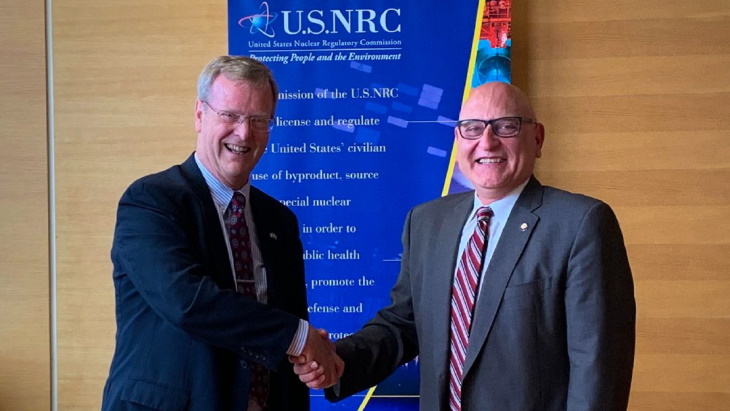The charter agreement on advanced reactor and small modular reactor (SMR) technologies formally establishes the collaborative relationship between the Canadian Nuclear Safety Commission (CNSC) and the US Nuclear Regulatory Commission (NRC), and the overall work to be done by them both relating to the BWRX-300 reactor design.

NRC Executive Director for Operations Dan Dorman and CNSC Executive Vice-President and Chief Regulatory Operations Officer Ramzi Jammal at the signing ceremony, which took place in Vienna (Image: CNSC/NRC)
International collaboration and initiatives to harmonise the regulatory process are seen as vital for the safe and successful deployment of new reactor designs such as SMRs. The CNSC and NRC have been working together on this for several years, and in 2019 signed a memorandum of cooperation (MoC) covering technical reviews of advanced reactor and SMR technologies.
The regulatory agreement comes after Tennessee Valley Authority (TVA) and Ontario Power Generation (OPG) earlier this year announced plans to work together to develop and deploy SMRs in Canada and the USA. GE-Hitachi's (GEH) BWRX-300 - a 300 MWe water-cooled, natural circulation SMR - has already been selected by OPG for deployment at its Darlington site, and TVA is preparing to submit a licence application to build a BWRX-300 at Clinch River.
A memorandum of understanding between TVO and OPG allows the companies to coordinate efforts on the design, licensing, construction, and operation of SMRs, but differing regulations, regulatory guidance and review practices for licensing in Canada and the United States may impact the licensing and construction timelines for the proposed projects.
The new charter between the CNSC and USNRC aims to enhance their cooperative work under the 2019 MoC by working on regulatory and safety issues in the licensing review of the BWRX-300 design. Objectives include collaborating to reduce duplication of licensing review efforts, jointly utilising third party verification, identifying areas for collaborative verification, sharing expertise and leveraging analysis done by each organisation, while supporting each regulator's adherence to national laws and regulations. The ultimate goal will be joint safety reviews and/or a risk-informed acceptance of the other regulator's technical conclusions, according to information from the CNSC.
The agreement aims to enhance the regulators' pre-application activities with OPG and TVA, and with GEH for design-led activities. OPG, TVA and GEH will identify licensing topics for consideration by the CNSC and NRC for cooperative reviews. They will also identify challenges with applying existing guidance or frameworks, provide technical information to facilitate timely and efficient safety reviews, and ensure efficient communication with both regulators.
CNSC and NRC will develop work plans to identify specific deliverables, conduct "coordinated and efficient" technical reviews within established schedules, and work to align on common regulatory technical positions that enhance standardisation of the GEH BWRX-300 SMR design "to the extent practicable".
This work will be monitored by the Advanced Reactor Technologies and Small Modular Reactors Sub Committee (ART-SMR Sub Committee) and as set out under the Terms of Reference for the MOC between the CNSC and the USNRC. Working groups of the CNSC and USNRC staff will be established as needed.
"We're aiming for joint safety reviews or recognition of each other's technical conclusions and to find areas where we can jointly verify safety-related information, and leverage each agency's analyses," the NRC said on Twitter.
"This agreement is a prime example of learning and working together, which will bring about efficiencies while always maintaining safety," CNSC President and CEO Rumina Velshi said.
Researched and written by World Nuclear News